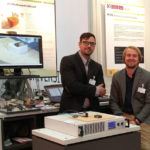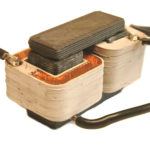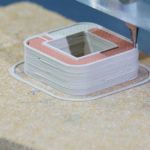The scientific members of staff, Johannes Rudolph and Fabian Lorenz of the Technical University of Chemnitz, Professorship of Electrical Energy Conversion Systems and Drives, have developed an innovative production process for the manufacture of electric motors. Components of different materials can therefore be produced in one operation by means of an additive production process. Metallic and ceramic pastes, which are offset with a binder, are layered in 3D multi-material printing with the aid of a standard CNC 3-axis machine and ViscoTec print heads. Due to the different material pairing, the power density of the resulting electrical coils can be increased. An additional increase in the power density can be achieved by the targeted introduction of cooling channels in the coil or into the laminated core.
In addition to the goal of producing electric motors with greater overload capability, the scientists are also investigating the possibility of constructively using the process in the design of electrical machines. Besides the integration of cooling geometries, the technology also allows three-dimensional supply of magnetic fluxes or the introduction of electrical windings in areas which are not accessible with conventional methods. As a result, machines can be manufactured that are optimally tailored to their operating conditions. Particularly interesting in this context is weight reduction, an aspect which is of great interest to the aerospace industry. The two researchers started developing the process at the end of 2015 and have agreed to discuss their experiences and findings since their collaboration with ViscoTec.
What is the innovation in your manufacturing process in combination with material pairing?
The innovation of the technology is that, through carrying out several experiments, we have succeeded in making use of the metallic and ceramic materials developed by us in the form of pastes for the printing process. The challenge was to optimally coordinate the mechanical and physical properties of the existing material pair. In addition, the flowability of the paste had to exist to be able to process these in an extrusion process. Adequate shape stability was also necessary to obtain the desired design after extrusion. The process developed by us offers the possibility to achieve different material combinations of ceramics and metals in an additive production process, which cannot be achieved with current conventional production methods.
What challenges or hurdles were encountered in the manufacturing process of your electric motors?
In addition to the optimization of the material properties for 3D printing, the adjustment of the shrinkage values of the various materials during the drying and sintering process has proven to be very difficult. By specifically setting the temperature in the sintering oven and matching the paste properties, we were able to counteract the problem. Furthermore, the temperature changes can be used to optimize the properties of the materials in order to achieve an even higher power density.
How did you hear about the ViscoTec print heads?
Whilst researching on the Internet we were made aware of the ViscoTec extruder through a press release. During this time, we experimented with our own hand-made extruder. With this type of extrusion, however, we had not been able to achieve the desired precision in the dosing of highly viscous metallic and ceramic pastes. After our initial contact, we accepted an invitation to Töging am Inn. During the meeting, we were given the opportunity to present our procedure. Based on the experience gained in the feeding of highly viscous fluids and a relevant innovative product portfolio, it was quickly clear that the extruder from ViscoTec represent an ideal basis for the further optimization of our technology. ViscoTec very kindly loaned us a unit, for which we would like to thank the company once again. With the subsequent integration into the 3D printer, we were able to experiment extensively with the print head and adjust the printing parameters to the highly viscous pastes.
Why did you ultimately choose ViscoTec print heads?
Dosing accuracy and precision are of enormous importance for the printing process of electric motors. In particular, the start and end points of each line were significantly improved by the print heads from ViscoTec. This results in an even printed image. At the same time, the print heads allow an unproblematic adjustment of the volume flows during the printing process. This allows us to achieve the targeted characteristics we wanted.
What convinced you to work with ViscoTec?
ViscoTec impressed us the first time we contacted them, showing a great willingness to help and were open to new technologies. The ViscoTec print heads helped us to achieve the project of 3D multi-material printing and to optimize the production process developed by us. Another important aspect of good cooperation was the fast and uncomplicated communication, which facilitated the commissioning and adaptation of the print heads into our existing system considerably.
The post Innovative electric motors from a 3D printer appeared first on ViscoTec Pumpen- u. Dosiertechnik GmbH.




